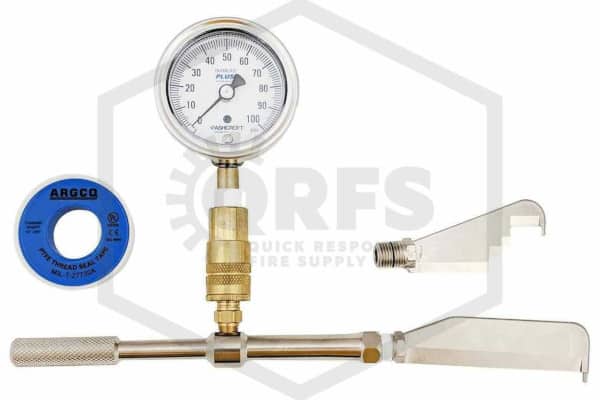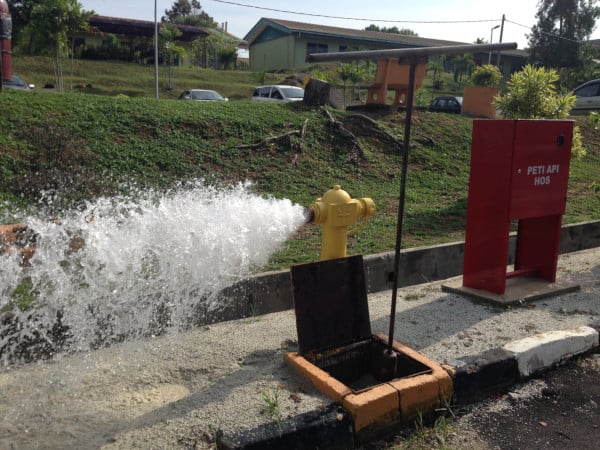Hydrant pressure tests ensure adequate water supply to fire protection systems – and a pitot gauge is an essential tool for getting the job done
Reliable sources of water are essential in a fire emergency. Hydrant pressure tests ensure this reliability by determining the pressure and rate of flow at any point in a city’s water distribution system. This is accomplished by measuring static (non-flowing) and residual (flowing) pressure, as well as calculating the rate of discharge in gallons per minute (GPM) of tested fire hydrants. Read on as we describe why hydrant pressure tests are important, who performs them, and how they’re carried out.
Why are hydrant pressure tests important?
Hydrant pressure tests assess the performance of a city’s water distribution system and ensure that adequate flow and pressure are maintained for firefighters and fire protection systems. The data that is collected during these tests are used for several important things. First, this information leads to discoveries of leaks or heavy pipe-wall deposits in the system, because reduced rates of flow often stem from issues with blockage and other infrastructure problems. Second, this data is vital for properly designing and installing fire sprinkler and standpipe systems. Incorrect water supply pressure and flow readings can lead to underdeveloped systems, which then require additional fire pumps or an expensive overhaul of pipes.
Who performs them?
Hydrant pressure tests are carried out by city officials and professional contractors; a city typically tests its distribution system every five years. They follow guidelines set by the National Fire Protection Association’s NFPA 291: Recommended Practice for Water Flow Testing and Marking of Hydrants when gathering data. Testers often then mark the fire hydrants using a color coding system specified in section 5.1 of NFPA 291 (2022 edition) when they’re finished. The color system is an efficient way to notify fire departments of the water supply’s strength, and hydrants are categorized according to the GPM of their flow, as illustrated below:
- Light blue: an AA hydrant with 1,500 GPM or more; considered “Very good flow.”
- Green: an A hydrant with 1,000-1,499 GPM; “Good for residential areas.”
- Orange: a B hydrant with 500-999 GPM; “Adequate marginally.”
- Red: a C hydrant with below 500 GPM; “Inadequate.”
For more detail on hydrant colors, read our blog “Fire Hydrant Colors: Their NFPA Spectrum and Meaning.”
Conducting a hydrant pressure test
Before beginning the test, a life safety professional needs several pieces of equipment. The first is a hand-held pitot gauge. This instrument is used to take the pressure readings that allow for calculating the flow rate. An outlet-nozzle cap that’s outfitted with a pressure gauge that goes right onto the residual hydrant is another key tool. It’s also important to measure the inside diameter of each flow hydrant’s outlet nozzle, and a simple ruler can accomplish this task. Finally, a hydrant wrench is required to access hydrants and take residual and flow readings.
Here are 8 useful steps for executing a single-hydrant pressure test:
- Determine the test area by picking a hydrant that’s downstream of and closest to the building’s supply line for pressure readings.
- Next, select a hydrant further downstream as a secondary flowing hydrant to provide pitot readings.
- Remove the nozzle cap of the pressure hydrant and add the pressure gauge to its outlet.
- Open its valve completely and gather static pressure reading (Water should not be flowing).
- Then, open the flowing hydrant’s valve. Always be cautious of nearby obstacles and traffic. A diffuser may be useful.
- After 30 seconds of steady flow and when the pressure needle stabilizes, record the residual pressure from the hydrant’s pressure gauge.
- Following that, use a pitot gauge to measure the rate of discharge.
- Close the hydrant slowly, as well as all valves involved. Check for leaks and ensure hydrants are back in working condition.
For a detailed version of these steps and how to use a pitot gauge, check out our other blogs:

A pitot gauge is a critical piece of equipment for hydrant pressure tests. When purchasing one to do the job correctly, it’s important to consider several things. Given the wet working conditions while using a pitot gauge, it should have a handle with a good grip. Make sure it can be held in a light but firm grasp while executing a test. A rotating pitot gauge can also make it easier to read measurements, and a quick-disconnect fitting makes draining the system much faster.
QRFS kits come with the aforementioned features and more! Check out our selection of flow testing kits and pitot gauge parts and testing accessories, including blades, test caps, handles, brass elbows, quick-connect fittings, and more.
If you have questions about this article or pitot gauges, call us at +1 (888) 361-6662 or email support@qrfs.com.
This blog was originally posted by Jason Hugo and Cameron Sharp at blog.qrfs.com on June 24, 2016, and updated on November 28, 2022. If you like what you’ve read, check us out on Facebook and Twitter.


